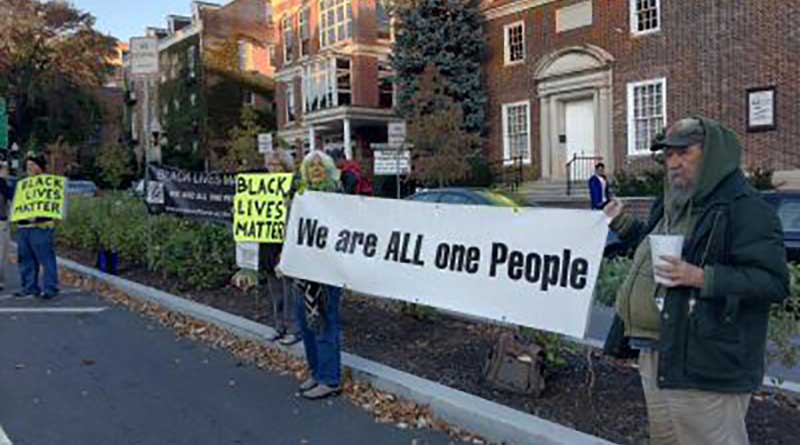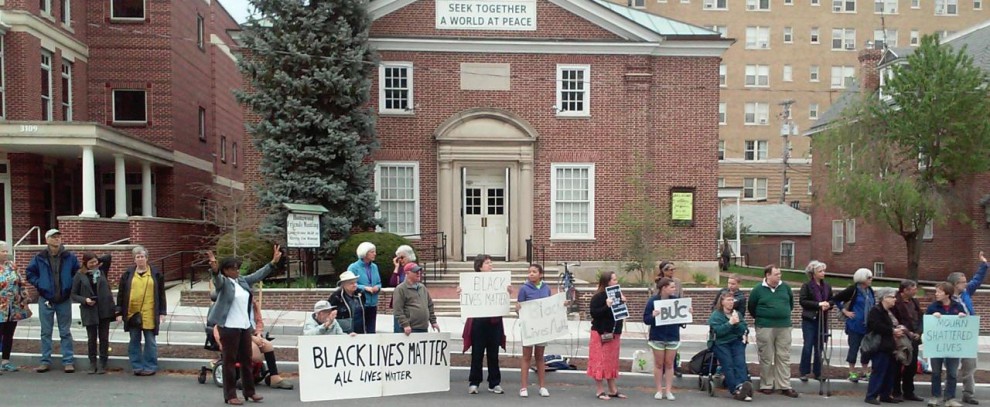
Throughout its history, Homewood Meeting in Baltimore, Md., has held a vigil against war and for peace in times of war. Since September 11, 2001, the meeting has held a vigil every Friday evening in front of the meetinghouse to protest the entry of the United States into Iraq and later to protest the use of drones and torture.
Holding vigils to protest the violence of war and torture continued until the unrest in Baltimore in April 2015 when the city rose up to protest the death of Freddie Gray in the custody of the police. At this time, the Peace and Justice Committee felt moved to address the issues of racial and economic inequality, injustice, and violence in our own community of Baltimore. The committee changed placards which focused on war in the Middle East to demonstrate solidarity with our neighbors of color in the city.
The new placards and banners initially read: “When Black Lives Matter / Then All Lives Matter.” There was concern by a member of the committee that our message didn’t address brown, Asian, and LGBTQ groups, but members of the committee decided to keep this message simple as blacks are the largest and most obviously discriminated against group in our city. At the outset, we grappled with the clarity of our concern, as some in the meeting and some passers-by urged “All lives matter,” and others remonstrated with us that saying “All lives matter” diminished the “Black lives matter” message. After a time, we changed some of the banners to read “Black Lives Matter / We Are All One People.” And most recently we also began to use the FCNL banner “Love Thy Neighbor, (No Exceptions).”
Our meetinghouse stands at the juncture of Charles Street and Art Museum Drive, a heavily trafficked location. We usually have 4–8 people an evening from Homewood and Stony Run Meetings, but have had as many as 25–30. Periodically students and teachers from Friends School of Baltimore attend. From the start of our local anti-violence focus, the vigil has received overwhelming support from motorists on their way home from work. As people in cars, buses, panel trucks, and bicyclers pass, they wave, honk and give a thumbs-up. Many call out, “Thank you” and black passersby often call, “All lives matter.” People take pictures of the vigil on their cell phones from their vehicles as they pass; others get out to ask permission, then stay to talk. More and more frequently people cross busy Charles Street to talk.
On rare occasions, some people, usually white men, will yell, “All lives matter,” “Blue lives matter,” or most recently “There’s a new sheriff in town.” We agree and ask people to look at the signs again. One man used to drive by in a large white pickup truck, blow his horn, which sounded like a train whistle, and yell, “White lives matter.” But these folks are rare.
We have had many rewarding conversations with people who park their cars to talk with us. Many blacks ask us why we are holding these signs. One woman who works at a nearby hospital came out one evening and said, “I see you people out here every week. Why are you doing this?” A mother came one night with her children, hugged each of us, and thanked us as did her children. The woman said she had just explained racism to her children. On another bitterly cold night a woman stopped, got out of her car, and brought each of the members of the vigil a cup of hot coffee, along with the words “Thanks for all that you do.” A young man recently said they have a Black Lives Matter group in Buffalo, N.Y., where he lives and that he would come to meeting on Sunday. Hopkins students come to enquire. Some stay to vigil.
Early on in this Baltimore-focused vigil, we prepared a brochure to present to people who came by to talk. When the Peace and Justice Committee asked meeting for business to approve the brochure, several people present raised questions and concerns. Our discernment over the wording of the brochure encouraged many people to consider their own white privilege, to attend to the structural racism in Baltimore, to observe the patterns of policing and the racially disproportionate arrests and incarceration of blacks in Baltimore. As a result of this early and discomforting discussion, the meeting decided to hold a threshing session on race.
Members of our meeting have asked why we hold this vigil in a very white area just south of Johns Hopkins University. Maybe we should consider moving it to another part of the city? Shouldn’t we hold placards for all groups? One 90-year-old African American member asked us to get out of our white enclave and get to know African Americans in the city. Others asked us to reconsider changing the vigil to another theme since we have been holding the Black Lives Matter concern for almost two years. Our vigil is important for both our black and white neighbors. Whites need to be reminded that they are part of a city with many problems and that they can be part of the solution. Blacks need to know that there are whites who see their plight and are willing to join in creating solutions. From this vigil we are branching out to work at other areas—court watch, bail reform in our state, and anti-violence study and program expansion as we seek a faithful grounding for our peacemaking efforts in Baltimore.




Comments on Friendsjournal.org may be used in the Forum of the print magazine and may be edited for length and clarity.